Development of Novel Polypropylene Syntactic Foams Containing Paraffin Microcapsules for Thermal Energy Storage Applications
Abstract
1. Introduction
2. Results and Discussions
2.1. Rheological and Morphological Properties
2.2. Thermal Properties
2.3. Mechanical Properties
2.4. General Comparison of the Physical Properties of the Prepared Syntactic Foams
3. Materials and Methods
3.1. Materials
3.2. Sample Preparation
3.2.1. Silanization of HGMs
- ➢
- Hydroxylation
- ▪
- 12 g of HGMs were added in a 0.5 M solution of NaOH
- ▪
- The solution was stirred using a magnetic anchor at 90 °C for 1 h
- ▪
- After the solution reached room temperature it was filtered and washed with distilled water until a pH = 7 was reached
- ▪
- The filter with the washed HGMs was then dried in a vacuum oven at 80 °C for 12 h
- ➢
- Silanization
- ▪
- 10 g of HGMs were mixed with a preheated solution (200 mL, 70 °C) of 50/50 mass of ethanol and distilled water plus 2 g of APTES.
- ▪
- After the mixture was mixed for 1.5 h the solution was cooled and filtered again as in the hydroxylation step
- ▪
- The silanized HGMs were filtered and then dried in a vacuum oven for 12 h at 80 °C.
3.2.2. Preparation of Multifunctional SFs
3.3. Experimental Techniques
3.3.1. Rheological and Morphological Analysis
3.3.2. Evaluation of the Thermal Properties
3.3.3. Evaluation of the Mechanical Properties of SFs
3.4. Statistical Analysis of the Experimental Data
4. Conclusions
Author Contributions
Funding
Institutional Review Board Statement
Informed Consent Statement
Data Availability Statement
Acknowledgments
Conflicts of Interest
References
- Wenlong, S.; Xiaokai, C.; Lu, W. Analysis of energy saving and emission reduction of vehicles using light weight materials. Energy Procedia 2016, 88, 889–893. [Google Scholar] [CrossRef]
- Pravilonis, T.; Sokolovskij, E. Analysis of composite material properties and their possibilities to use them in bus frame construction. Transport 2020, 35, 368–378. [Google Scholar] [CrossRef]
- Hara, D.; Özgen, G.O. Investigation of Weight Reduction of Automotive Body Structures with the Use of Sandwich Materials. Transp. Res. Procedia 2016, 14, 1013–1020. [Google Scholar] [CrossRef]
- Ashby, M.F.; Johnson, K. Materials and Design: The Art and Science of Material Selection in Product Design, 3rd ed.; Butterworth-Heinemann: Waltham, MA, USA, 2014; ISBN 9780080982052. [Google Scholar]
- Qi, C.; Yu, Q.; Zhao, Y. Fabrication and characterization of the thermoplastic and thermoset syntactic foam core-based sandwich composites. Polym. Compos. 2020, 41, 3052–3061. [Google Scholar] [CrossRef]
- Singh, A.K.; Patil, B.; Hoffmann, N.; Saltonstall, B.; Doddamani, M.; Gupta, N. Additive Manufacturing of Syntactic Foams: Part 1: Development, Properties, and Recycling Potential of Filaments. JOM 2018, 70, 303–309. [Google Scholar] [CrossRef]
- Rueda, M.M.; Auscher, M.C.; Fulchiron, R.; Périé, T.; Martin, G.; Sonntag, P.; Cassagnau, P. Rheology and applications of highly filled polymers: A review of current understanding. Prog. Polym. Sci. 2017, 66, 22–53. [Google Scholar] [CrossRef]
- Galvagnini, F.; Dorigato, A.; Fambri, L.; Fredi, G.; Pegoretti, A. Thermophysical Properties of Multifunctional Syntactic Foams Containing Phase Change Microcapsules for Thermal Energy Storage. Polymers 2021, 13, 20. [Google Scholar]
- Gupta, N.; Zeltmann, S.E.; Shunmugasamy, V.C.; Pinisetty, D. Applications of polymer matrix syntactic foams. JOM 2014, 66, 245–254. [Google Scholar] [CrossRef]
- Paul, D.; Velmurugan, R. Analysis of the specific properties of glass microballoon-epoxy syntactic foams under tensile and flexural loads. Mater. Today Proc. 2018, 5, 16956–16962. [Google Scholar]
- Zeltmann, S.E.; Chen, B.; Gupta, N. Thermal expansion and dynamic mechanical analysis of epoxy matrix–borosilicate glass hollow particle syntactic foams. J. Cell. Plast. 2018, 54, 463–481. [Google Scholar] [CrossRef]
- Ashrith, H.S.; Doddamani, M.; Gaitonde, V. Effect of wall thickness and cutting parameters on drilling of glass microballoon/epoxy syntactic foam composites. Compos. Struct. 2019, 211, 318–336. [Google Scholar] [CrossRef]
- Dando, K.R.; Cross, W.M.; Robinson, M.J.; Salem, D.R. Production and characterization of epoxy syntactic foams highly loaded with thermoplastic microballoons. J. Cell. Plast. 2018, 54, 499–514. [Google Scholar] [CrossRef]
- He, S.; Carolan, D.; Fergusson, A.; Taylor, A.C. Toughening epoxy syntactic foams with milled carbon fibres: Mechanical properties and toughening mechanisms. Mater. Des. 2019, 169, 107654. [Google Scholar] [CrossRef]
- Shahapurkar, K.; Garcia, C.D.; Doddamani, M.; Mohan Kumar, G.C.; Prabhakar, P. Compressive behavior of cenosphere/epoxy syntactic foams in arctic conditions. Compos. Part B Eng. 2018, 135, 253–262. [Google Scholar] [CrossRef]
- Wu, X.; Gao, Y.; Wang, Y.; Fan, R.; Ali, Z.; Yu, J.; Yang, K.; Sun, K.; Li, X.; Lei, Y.; et al. Recent developments on epoxy-based syntactic foams for deep sea exploration. J. Mater. Sci. 2021, 56, 2037–2076. [Google Scholar] [CrossRef]
- Jayavardhan, M.L.; Bharath Kumar, B.R.; Doddamani, M.; Singh, A.K.; Zeltmann, S.E.; Gupta, N. Development of glass microballoon/HDPE syntactic foams by compression molding. Compos. Part B Eng. 2017, 130, 119–131. [Google Scholar] [CrossRef]
- Yalcin, B. Hollow Glass Microspheres in Polyurethanes. In Hollow Glass Microspheres for Plastics, Elastomers, and Adhesives Compounds; Elsevier: Amsterdam, The Netherlands, 2015; pp. 175–200. ISBN 9781455775507. [Google Scholar]
- Ya, B.; Wang, Y.; Meng, L.; Zhou, B.; Zhang, X. Study on the performance of syntactic foam reinforced by hybrid functionalized carbon nanotubes. J. Appl. Polym. Sci. 2020, 137, 48586. [Google Scholar] [CrossRef]
- Pereira da Cunha, J.; Eames, P. Thermal energy storage for low and medium temperature applications using phase change materials—A review. Appl. Energy 2016, 177, 227–238. [Google Scholar] [CrossRef]
- Pielichowska, K.; Pielichowski, K. Phase change materials for thermal energy storage. Prog. Mater. Sci. 2014, 65, 67–123. [Google Scholar] [CrossRef]
- Fleischer, A.S. Thermal Energy Storage Using Phase Change Materials: Fundamentals and Applications; Springer: Minneapolis, MN, USA, 2015; ISBN 9783319209210. [Google Scholar]
- Sarı, A.; Biçer, A.; Alkan, C. Thermal energy storage characteristics of poly(styrene-co-maleic anhydride)-graft-PEG as polymeric solid–solid phase change materials. Sol. Energy Mater. Sol. Cells 2017, 161, 219–225. [Google Scholar] [CrossRef]
- Alva, G.; Liu, L.; Huang, X.; Fang, G. Thermal energy storage materials and systems for solar energy applications. Renew. Sustain. Energy Rev. 2017, 68, 693–706. [Google Scholar] [CrossRef]
- Amaral, C.; Vicente, R.; Ferreira, V.M.; Silva, T. Polyurethane foams with microencapsulated phase change material: Comparative analysis of thermal conductivity characterization approaches. Energy Build. 2017, 153, 392–402. [Google Scholar] [CrossRef]
- Sami, S.; Sadrameli, S.M.; Etesami, N. Thermal properties optimization of microencapsulated a renewable and non-toxic phase change material with a polystyrene shell for thermal energy storage systems. Appl. Therm. Eng. 2018, 130, 1416–1424. [Google Scholar]
- Shchukina, E.M.; Graham, M.; Zheng, Z.; Shchukin, D.G. Nanoencapsulation of phase change materials for advanced thermal energy storage systems. Chem. Soc. Rev 2018, 47, 4156. [Google Scholar] [CrossRef] [PubMed]
- Fredi, G.; Dorigato, A.; Fambri, L.; Unterberger, S.H.; Pegoretti, A. Effect of phase change microcapsules on the thermo-mechanical, fracture and heat storage properties of unidirectional carbon/epoxy laminates. Polym. Test. 2020, 91, 106747. [Google Scholar] [CrossRef]
- Valentini, F.; Morandini, F.; Bergamo, M.; Dorigato, A. Development of eco-sustainable plasters with thermal energy storage capability. J. Appl. Phys. 2020, 128, 075103. [Google Scholar] [CrossRef]
- Anisur, M.R.; Mahfuz, M.H.; Kibria, M.A.; Saidur, R.; Metselaar, I.H.S.C.; Mahlia, T.M.I. Curbing global warming with phase change materials for energy storage. Renew. Sustain. Energy Rev. 2013, 18, 23–30. [Google Scholar]
- Kahraman Döğüşcü, D.; Kızıl, Ç.; Biçer, A.; Sarı, A.; Alkan, C. Microencapsulated n-alkane eutectics in polystyrene for solar thermal applications. Sol. Energy 2018, 160, 32–42. [Google Scholar] [CrossRef]
- Arshad, A.; Jabbal, M.; Yan, Y.; Darkwa, J. The micro-/nano-PCMs for thermal energy storage systems: A state of art review. Int. J. Energy Res. 2019, 43, 5572–5620. [Google Scholar]
- Fredi, G.; Dorigato, A.; Fambri, L.; Pegoretti, A. Wax confinement with carbon nanotubes for phase changing epoxy blends. Polymers 2017, 9, 405. [Google Scholar] [CrossRef]
- Fredi, G.; Dorigato, A.; Fambri, L.; Pegoretti, A. Multifunctional epoxy/carbon fiber laminates for thermal energy storage and release. Compos. Sci. Technol. 2018, 158, 101–111. [Google Scholar] [CrossRef]
- Fredi, G.; Dorigato, A.; Pegoretti, A. Multifunctional glass fiber/polyamide composites with thermal energy storage/release capability. Express Polym. Lett. 2018, 12, 349–364. [Google Scholar] [CrossRef]
- Fredi, G.; Dorigato, A.; Unterberger, S.; Artuso, N.; Pegoretti, A. Discontinuous carbon fiber/polyamide composites with microencapsulated paraffin for thermal energy storage. J. Appl. Polym. Sci. 2019, 136, 47408. [Google Scholar] [CrossRef]
- Dorigato, A.; Fredi, G.; Pegoretti, A. Thermo-mechanical behavior of novel wood laminae-thermoplastic starch biodegradable composites with thermal energy storage/release capability. Front. Mater. 2019, 6, 76. [Google Scholar] [CrossRef]
- Dorigato, A.; Fredi, G.; Pegoretti, A. Application of the thermal energy storage concept to novel epoxy–short carbon fiber composites. J. Appl. Polym. Sci. 2019, 136, 47434. [Google Scholar] [CrossRef]
- Fredi, G.; Dorigato, A.; Pegoretti, A. Novel reactive thermoplastic resin as a matrix for laminates containing phase change microcapsules. Polym. Compos. 2019, 40, 3711–3724. [Google Scholar] [CrossRef]
- Fredi, G.; Dorigato, A.; Pegoretti, A. Dynamic-mechanical response of carbon fiber laminates with a reactive thermoplastic resin containing phase change microcapsules. Mech. Time-Dependent Mater. 2020, 24, 395–418. [Google Scholar] [CrossRef]
- Fredi, G.; Brünig, H.; Vogel, R.; Scheffler, C. Melt-spun polypropylene filaments containing paraffin microcapsules for multifunctional hybrid yarns and smart thermoregulating thermoplastic composites. Express Polym. Lett. 2019, 13, 1071–1087. [Google Scholar] [CrossRef]
- Galvagnini, F.; Fredi, G.; Dorigato, A.; Fambri, L.; Pegoretti, A. Mechanical behaviour of multifunctional epoxy/hollow glass microspheres/paraffin microcapsules syntactic foams for thermal management. Polymers 2021, 13, 2896. [Google Scholar] [CrossRef]
- Gogoi, R.; Kumar, N.; Mireja, S.; Ravindranath, S.S.; Manik, G.; Sinha, S. Effect of Hollow Glass Microspheres on the Morphology, Rheology and Crystallinity of Short Bamboo Fiber-Reinforced Hybrid Polypropylene Composite. JOM 2019, 71, 548–558. [Google Scholar] [CrossRef]
- Valentini, F.; Fambri, L.; Dorigato, A.; Pegoretti, A. Production and Characterization of TES-EPDM Foams with Paraffin for Thermal Management Applications. Front. Mater. 2021, 8, 660656. [Google Scholar] [CrossRef]
- Bollin, S.; Motor, F. Productivity Advantages of Lightweight Injection Molded Thermoplastics Enabled by 3M Hollow Glass Microspheres. Available online: https://speautomotive.com/wp-content/uploads/2020/12/Productivity-Advantages-of-Lightweight-Injection-Molded-Thermoplastics-Bonded-by-3M-Hollow-Glass-Microspheres.pdf (accessed on 8 November 2022).
- Ding, J.; Liu, Q.; Ye, F.; Zhang, H.; Gao, Y.; Zhang, B. Compressive properties of co-continuous hollow glass microsphere/epoxy resin syntactic foams prepared using resin transfer molding. J. Reinf. Plast. Compos. 2020, 39, 132–143. [Google Scholar] [CrossRef]
- Gupta, N.; Pinisetty, D. A review of thermal conductivity of polymer matrix syntactic foams—Effect of hollow particle wall thickness and volume fraction. JOM 2013, 65, 234–245. [Google Scholar] [CrossRef]
- Gogoi, R.; Manik, G. Development of thermally conductive and high-specific strength polypropylene composites for thermal management applications in automotive. Polym. Compos. 2021, 42, 1945–1960. [Google Scholar] [CrossRef]
- Bharath Kumar, B.R.; Doddamani, M.; Zeltmann, S.E.; Gupta, N.; Uzma; Gurupadu, S.; Sailaja, R.R.N. Effect of particle surface treatment and blending method on flexural properties of injection-molded cenosphere/HDPE syntactic foams. J. Mater. Sci. 2016, 51, 3793–3805. [Google Scholar] [CrossRef]
- Huang, C.; Huang, Z.; Lv, X.; Zhang, G.; Wang, Q.; Wang, B. Surface modification of hollow glass microsphere with different coupling agents for potential applications in phenolic syntactic foams. J. Appl. Polym. Sci. 2017, 134, 44415. [Google Scholar] [CrossRef]
- Çelebi, H. Thermal Conductivity and Tensile Properties of Hollow Glass Microsphere/Polypropylene Composites. Anadolu Univ. J. Sci. Technol. A Appl. Sci. Eng. 2017, 18, 746. [Google Scholar] [CrossRef]
- Vignali, A.; Iannace, S.; Falcone, G.; Utzeri, R.; Stagnaro, P.; Bertini, F. Lightweight poly(ε-caprolactone) composites with surface modified hollow glass microspheres for use in rotational molding: Thermal, rheological and mechanical properties. Polymers 2019, 11, 624. [Google Scholar] [CrossRef]



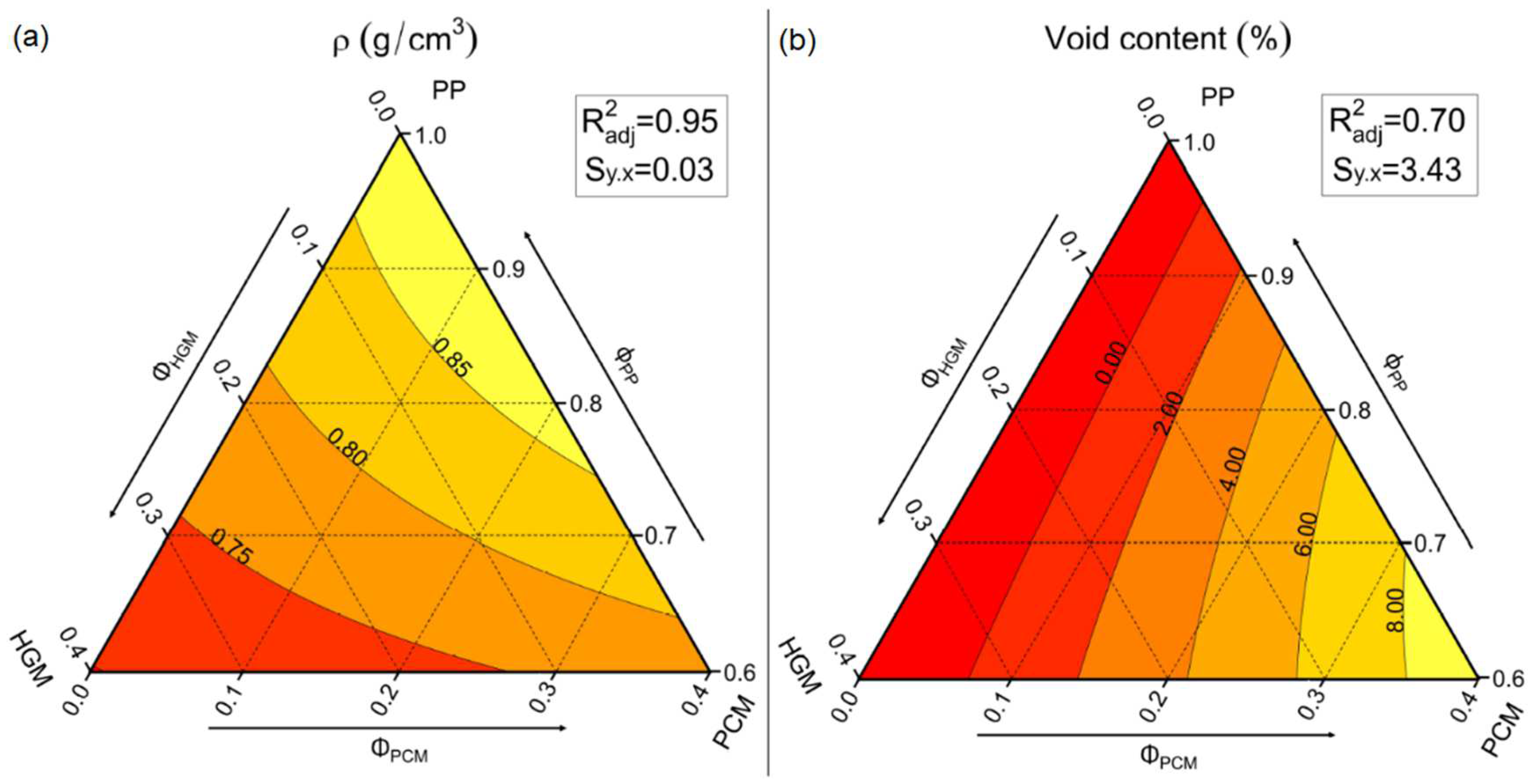
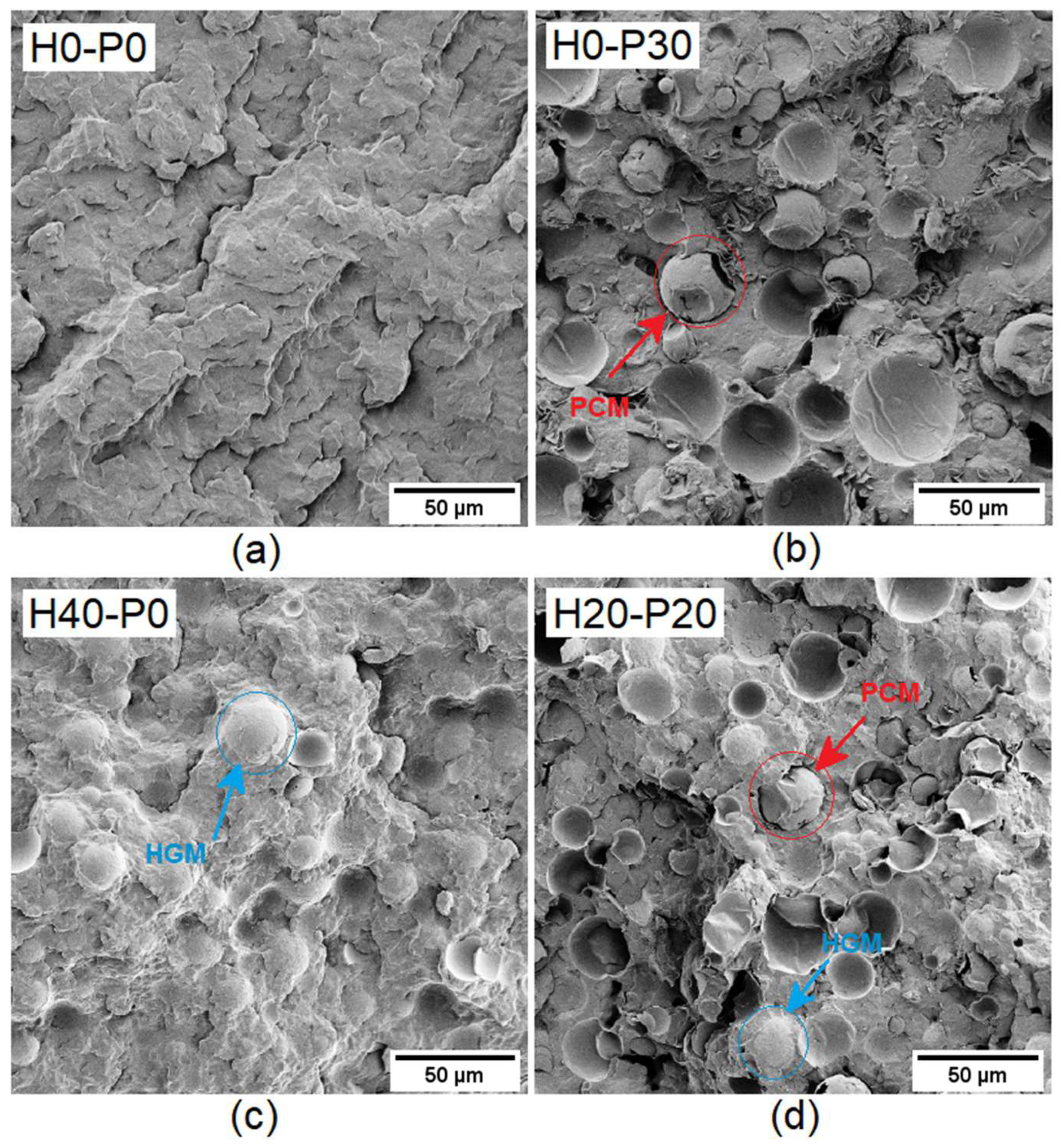

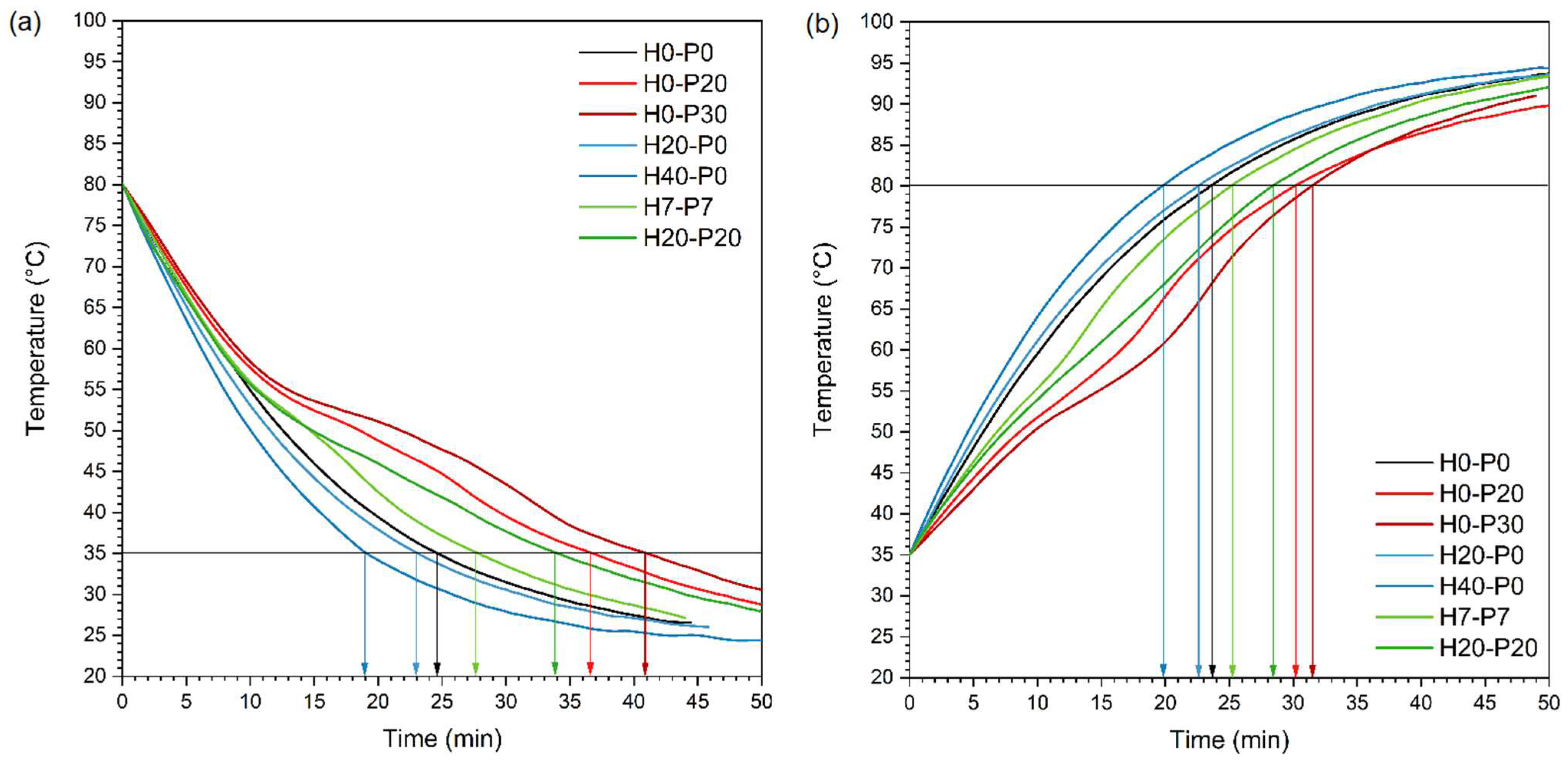
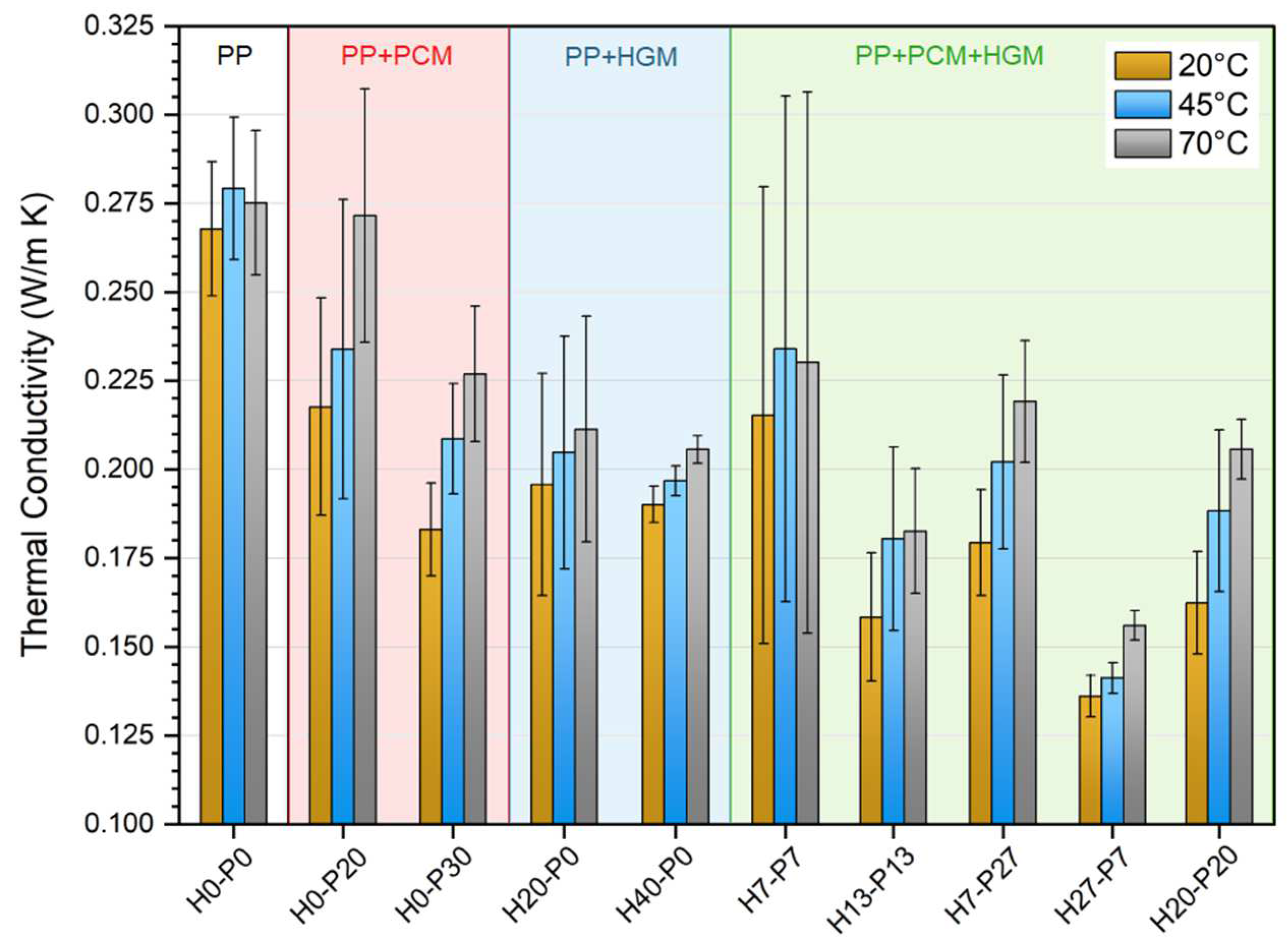
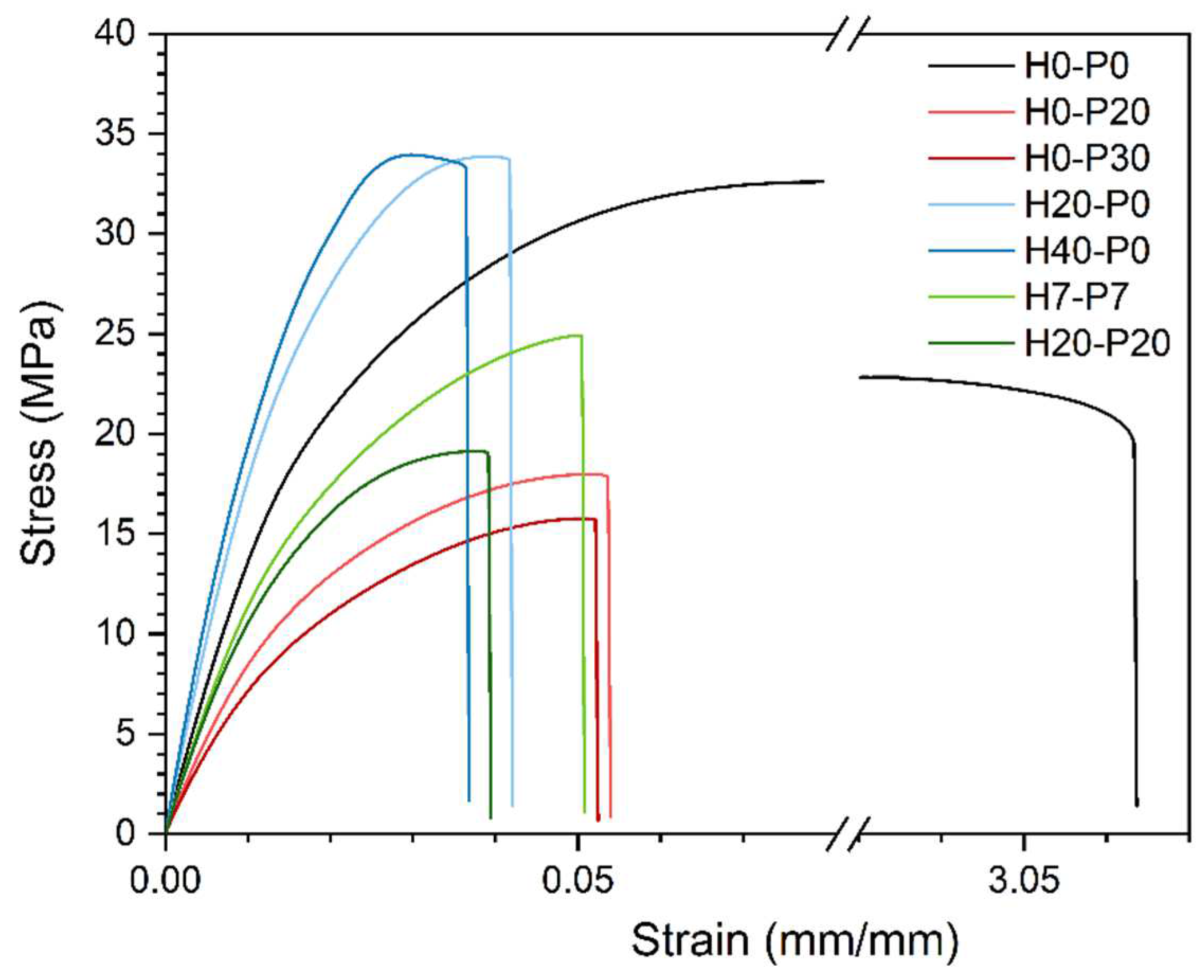
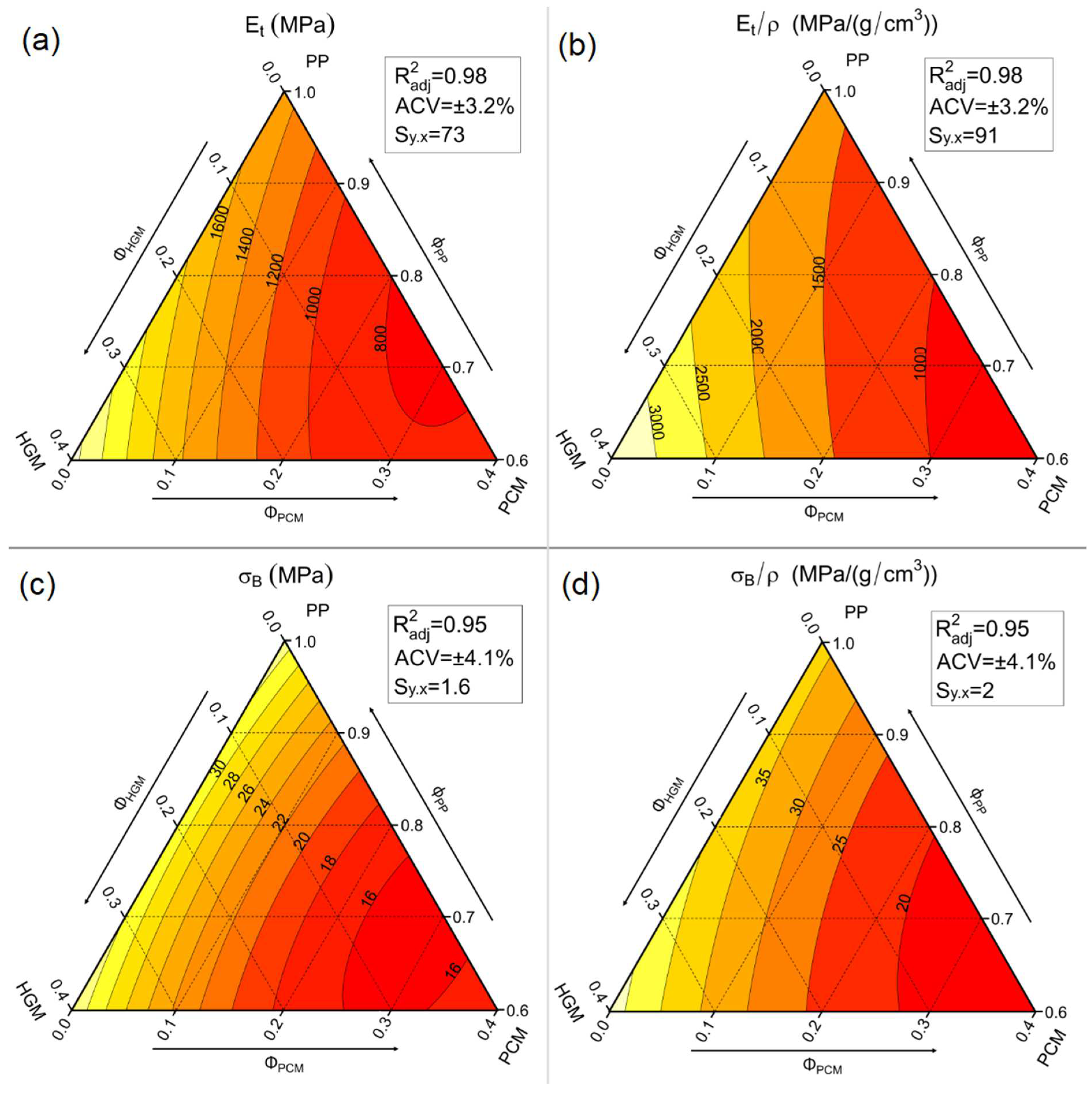

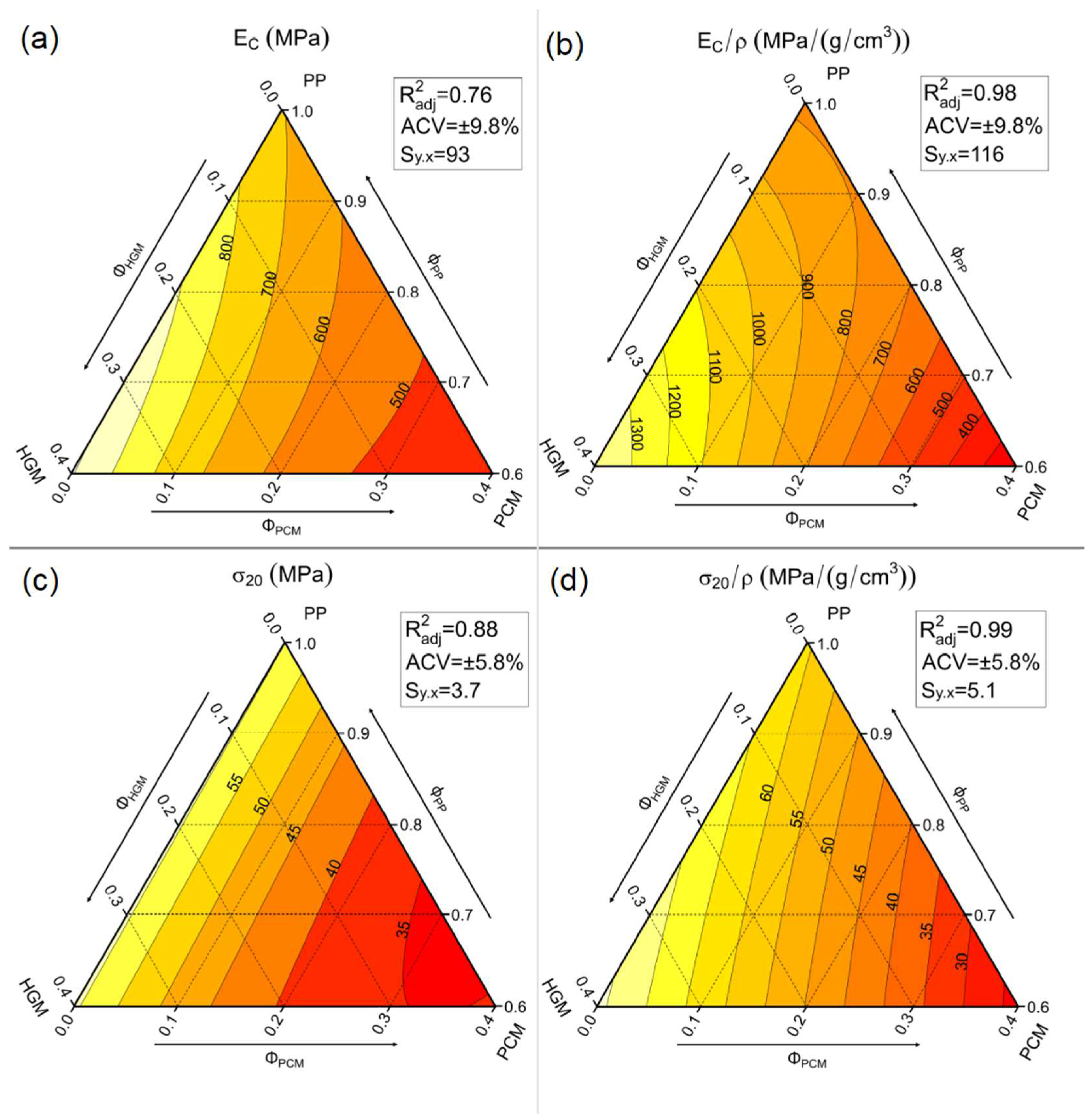


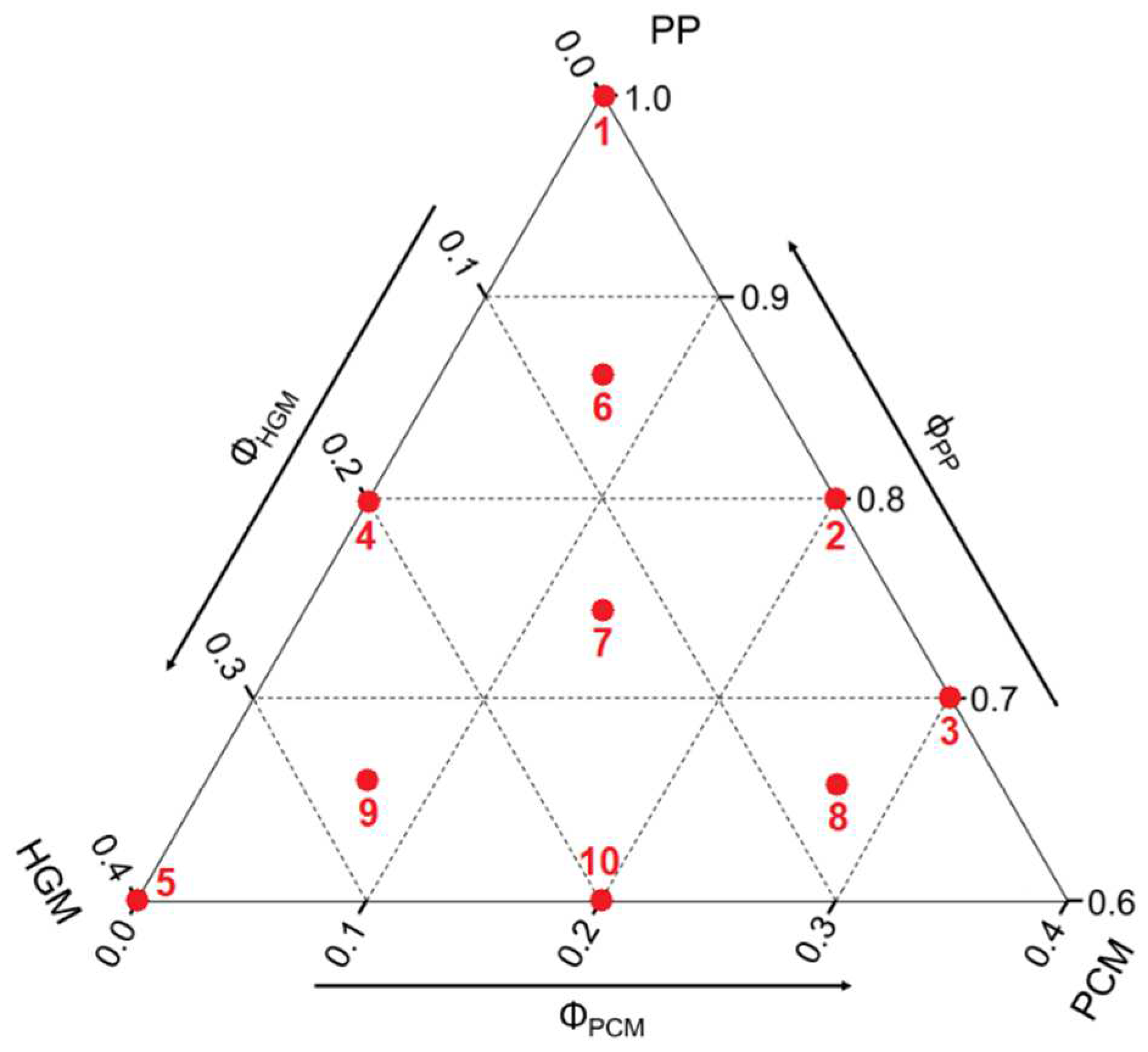
| Sample | Crossover Point | Constituents | |
|---|---|---|---|
| (rad/s) | G′, G″ (MPa) | ||
| H0-P0 | 20.5 | 0.020 | PP |
| H0-P20 | 28.2 | 0.019 | PP + PCM |
| H0-P30 | 35.0 | 0.024 | |
| H20-P0 | 26.7 | 0.043 | PP + HGM |
| H40-P0 | 21.6 | 0.098 | |
| H7-P7 | 36.0 | 0.027 | PP + HGM + PCM |
| H13-P13 | 34.4 | 0.034 | |
| H7-P27 | 39.2 | 0.023 | |
| H27-P7 | 42.7 | 0.031 | |
| H20-P20 | 47.5 | 0.039 | |
| Sample | (g/cm3) | (g/cm3) | Void Content (%) |
|---|---|---|---|
| H0-P0 | 0.90 | 0.90 | 0.0 |
| H0-P20 | 0.83 | 0.90 | 8.1 |
| H0-P30 | 0.86 | 0.91 | 5.0 |
| H20-P0 | 0.81 | 0.81 | 0.0 |
| H40-P0 | 0.70 | 0.72 | 1.8 |
| H7-P7 | 0.80 | 0.87 | 7.4 |
| H13-P13 | 0.77 | 0.84 | 9.1 |
| H7-P27 | 0.83 | 0.89 | 5.8 |
| H27-P7 | 0.74 | 0.78 | 5.0 |
| H20-P20 | 0.73 | 0.82 | 10.2 |
| Sample | Tm1 (°C) | ΔHm1 (J/g) | Tc (°C) | ΔHc (J/g) | ΔHm,th (J/g) |
|---|---|---|---|---|---|
| H0-P0 | - | 0.0 | - | 0.0 | 0.0 |
| H0-P20 | 55.6 | 36.5 | 37.2 | 36.5 | 41.4 |
| H0-P30 | 55.7 | 58.4 | 37.3 | 58.2 | 62.1 |
| H20-P0 | - | 0.0 | - | 0.0 | 0.0 |
| H40-P0 | - | 0.0 | - | 0.0 | 0.0 |
| H7-P7 | 46.9 | 8.2 | 35.1 | 8.2 | 13.7 |
| H13-P13 | 54.6 | 22.4 | 36.6 | 22.3 | 27.5 |
| H7-P27 | 55.3 | 53.0 | 37.6 | 51.5 | 57.3 |
| H27-P7 | 54.6 | 11.4 | 36.4 | 11.3 | 13.7 |
| H20-P20 | 55.2 | 43.9 | 37.5 | 43.4 | 41.4 |
| Sample | t35–80 (min) | t80–35 (min) |
|---|---|---|
| H0-P0 | 23.5 | 24.6 |
| H0-P20 | 30.1 | 36.7 |
| H0-P30 | 31.4 | 41.0 |
| H20-P0 | 22.6 | 23.1 |
| H40-P0 | 19.8 | 19.1 |
| H7-P7 | 25.1 | 27.8 |
| H20-P20 | 28.4 | 34.0 |
| Samples | Et (MPa) | (MPa/(g/cm3)) | σB (MPa) | (MPa/(g/cm3)) | εB (mm/mm) |
|---|---|---|---|---|---|
| H0-P0 | 1509 ± 19 | 1677 ± 21 | 33.5 ± 0.5 | 37.2 ± 0.5 | 2.320 ± 1.970 |
| H0-P20 | 845 ± 55 | 1018 ± 66 | 17.4 ± 0.8 | 21.0 ± 1.0 | 0.048 ± 0.004 |
| H0-P30 | 758 ± 15 | 881 ± 17 | 15.5 ± 0.4 | 18.0 ± 0.5 | 0.048 ± 0.003 |
| H20-P0 | 1873 ± 61 | 2312 ± 75 | 31.8 ± 1.3 | 39.3 ± 1.6 | 0.042 ± 0.007 |
| H40-P0 | 2480 ± 66 | 3543 ± 94 | 33.8 ± 0.8 | 48.3 ± 1.1 | 0.037 ± 0.006 |
| H7-P7 | 1183 ± 65 | 1479 ± 81 | 23.6 ± 2.3 | 29.5 ± 2.9 | 0.044 ± 0.010 |
| H13-P13 | 1159 ± 31 | 1505 ± 39 | 20.9 ± 0.5 | 27.1 ± 0.7 | 0.041 ± 0.002 |
| H7-P27 | 751 ± 15 | 905 ± 18 | 14.6 ± 0.8 | 17.6 ± 1.0 | 0.038 ± 0.003 |
| H27-P7 | 1649 ± 37 | 2228 ± 50 | 24.5 ± 0.9 | 33.1 ± 1.2 | 0.030 ± 0.003 |
| H20-P20 | 1117 ± 39 | 1530 ± 53 | 17.9 ± 0.8 | 24.5 ± 1.1 | 0.035 ± 0.003 |
| Samples | EC (MPa) | (MPa/(g/cm3)) | σ20 (MPa) | (MPa/(g/cm3)) |
|---|---|---|---|---|
| H0-P0 | 685 ± 120 | 761 ± 133 | 54.3 ± 3.3 | 60.3 ± 3.7 |
| H0-P20 | 602 ± 40 | 725 ± 48 | 33.9 ± 1.9 | 40.8 ± 2.3 |
| H0-P30 | 421 ± 39 | 490 ± 45 | 27.5 ± 1.3 | 32.0 ± 1.5 |
| H20-P0 | 937 ± 116 | 1157 ± 143 | 58.4 ± 3.0 | 72.1 ± 3.7 |
| H40-P0 | 1011 ± 82 | 1444 ± 117 | 56.7 ± 3.6 | 81.0 ± 5.1 |
| H7-P7 | 714 ± 43 | 893 ± 54 | 45.3 ± 2.5 | 56.6 ± 3.1 |
| H13-P13 | 617 ± 65 | 801 ± 84 | 39.8 ± 1.9 | 51.7 ± 2.5 |
| H7-P27 | 543 ± 55 | 654 ± 66 | 31.2 ± 1.4 | 37.6 ± 1.7 |
| H27-P7 | 793 ± 83 | 1072 ± 112 | 41.4 ± 3.6 | 56.0 ± 4.9 |
| H20-P20 | 582 ± 42 | 797 ± 58 | 35.7 ± 2.4 | 48.9 ± 3.3 |
| Samples | KIC (MPa∙m1/2) |
|---|---|
| H0-P0 | 2.12 ± 0.07 |
| H0-P20 | 1.51 ± 0.06 |
| H0-P30 | 1.24 ± 0.06 |
| H20-P0 | 1.96 ± 0.06 |
| H40-P0 | 2.06 ± 0.14 |
| H7-P7 | 1.88 ± 0.14 |
| H13-P13 | 1.61 ± 0.09 |
| H7-P27 | 1.25 ± 0.05 |
| H27-P7 | 1.65 ± 0.10 |
| H20-P20 | 1.38 ± 0.07 |
| Property | Value | Unit | Test Method |
|---|---|---|---|
| Melt flow rate | 3.4 | g/10 min | ISO 1133-1 |
| Density | 0.90 | g/cm3 | ISO 1183-1 |
| Flexural modulus | 1500 | MPa | ISO 178 |
| Tensile stress at yield | 34 | MPa | ISO 527-1-2 |
| Tensile stress at break | 21 | MPa | ISO 527-1-2 |
| Tensile strain at break | 200 | % | ISO 527-1-2 |
| Vicat (A50) | 156 | °C | ISO 306 |
| HDT (0.45 MPa) | 91 | °C | ISO 75B-1-2 |
| # | Compositions | Compatibilizer (vol%) | PP (vol%) | HGM (vol%) | PCM (vol%) |
|---|---|---|---|---|---|
| 1 | H0-P0 | 5.00 | 95.00 | 0.00 | 0.00 |
| 2 | H0-P20 | 4.00 | 76.00 | 0.00 | 20.00 |
| 3 | H0-P30 | 3.50 | 66.50 | 0.00 | 30.00 |
| 4 | H20-P0 | 4.00 | 76.00 | 20.00 | 0.00 |
| 5 | H40-P0 | 3.00 | 57.00 | 40.00 | 0.00 |
| 6 | H7-P7 | 4.33 | 82.33 | 6.70 | 6.70 |
| 7 | H13-P13 | 3.67 | 69.67 | 13.33 | 13.33 |
| 8 | H7-P27 | 3.33 | 63.33 | 6.67 | 26.67 |
| 9 | H27-P7 | 3.33 | 63.33 | 26.67 | 6.67 |
| 10 | H20-P20 | 3.00 | 57.00 | 20.00 | 20.00 |
Publisher’s Note: MDPI stays neutral with regard to jurisdictional claims in published maps and institutional affiliations. |
© 2022 by the authors. Licensee MDPI, Basel, Switzerland. This article is an open access article distributed under the terms and conditions of the Creative Commons Attribution (CC BY) license (https://creativecommons.org/licenses/by/4.0/).
Share and Cite
Galvagnini, F.; Dorigato, A.; Fambri, L.; Pegoretti, A. Development of Novel Polypropylene Syntactic Foams Containing Paraffin Microcapsules for Thermal Energy Storage Applications. Molecules 2022, 27, 8520. https://doi.org/10.3390/molecules27238520
Galvagnini F, Dorigato A, Fambri L, Pegoretti A. Development of Novel Polypropylene Syntactic Foams Containing Paraffin Microcapsules for Thermal Energy Storage Applications. Molecules. 2022; 27(23):8520. https://doi.org/10.3390/molecules27238520
Chicago/Turabian StyleGalvagnini, Francesco, Andrea Dorigato, Luca Fambri, and Alessandro Pegoretti. 2022. "Development of Novel Polypropylene Syntactic Foams Containing Paraffin Microcapsules for Thermal Energy Storage Applications" Molecules 27, no. 23: 8520. https://doi.org/10.3390/molecules27238520
APA StyleGalvagnini, F., Dorigato, A., Fambri, L., & Pegoretti, A. (2022). Development of Novel Polypropylene Syntactic Foams Containing Paraffin Microcapsules for Thermal Energy Storage Applications. Molecules, 27(23), 8520. https://doi.org/10.3390/molecules27238520








